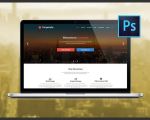- Understanding Single Page Websites
- Why Choose Single Page Website Design?
- Key Elements of a Successful Single Page Website
- Step-by-Step Guide to Designing a Single Page Website
- Common Mistakes to Avoid in Single Page Website Design
- Tools and Resources for Building Single Page Websites
Understanding Single Page Websites
A single-page website, also known as a one-page website, is a website that contains all its content on a single page, as opposed to a traditional multi-page website with multiple sections or pages. These websites are designed to offer a streamlined user experience where all information is presented without the need for navigating between different pages.
Single-page websites have gained popularity because they provide a focused, minimalistic experience, often emphasizing a specific message, product, or service. These websites are ideal for businesses or projects that do not require extensive content and instead aim for simplicity and directness. Whether it’s for a personal portfolio, a small business, or a promotional landing page, single-page websites provide an efficient way to present information without overwhelming the visitor.
Why Choose Single Page Website Design?
There are several reasons why single-page websites have become a popular choice for many businesses and individuals. Here are a few of the key benefits:
1. Simplicity and Focus: A single-page design allows you to focus on delivering one clear message without distraction. Whether it's promoting a product or sharing personal achievements, a one-page website provides a more cohesive and focused narrative.
2. Mobile-Friendly: As mobile traffic continues to rise, single-page websites offer a more seamless experience for users on smartphones and tablets. Scrolling is more intuitive than navigating multiple pages on small screens.
3. Faster Loading Times: Since all the content is contained in one page, single-page websites can be faster to load compared to traditional websites that have to load multiple pages and assets.
4. Improved Conversion Rates: A single-page website with a clear call to action (CTA) can help guide visitors toward taking specific actions, such as making a purchase or signing up for a service. This streamlined process often results in higher conversion rates.
Key Elements of a Successful Single Page Website
Designing a successful single-page website requires careful attention to several key elements. These components work together to create a user-friendly and effective experience. Here are the main elements to consider:
1. Clear Navigation: Even though it’s a one-page site, users still need to navigate between sections smoothly. Implementing a fixed navigation bar with anchor links that smoothly scroll to different sections is crucial.
2. Engaging Visuals: High-quality images and graphics play an important role in drawing visitors in and making the content visually appealing. Consider using large background images, infographics, and videos to break up the text and keep visitors engaged.
3. Strong Calls to Action (CTA): A successful single-page website will have clear calls to action that guide users toward the next steps, whether it’s making a purchase, subscribing to a newsletter, or contacting the business.
4. Responsive Design: The website must adapt seamlessly to various screen sizes. Ensure your design works well on desktops, tablets, and smartphones.
5. Fast Loading Times: Performance is key to the success of a single-page website. Optimize images, scripts, and other assets to ensure fast loading speeds and a smooth user experience.
Step-by-Step Guide to Designing a Single Page Website
Designing a single-page website can seem daunting at first, but following a step-by-step process can simplify the task. Here’s how to design a simple yet effective single-page website:
1. Plan Your Content: Before jumping into the design, plan the content of your website. What key messages do you want to convey? Break down the content into sections such as an introduction, services or features, testimonials, and a call to action.
2. Create a Wireframe: Sketch a wireframe to visualize how your website will look. This doesn’t have to be fancy—just a basic layout that shows where different elements will go, such as the header, text sections, and navigation.
3. Design the Website: Using your wireframe as a guide, start designing your website. Focus on creating a visually appealing layout with easy navigation and a logical flow. Consider using tools like Adobe XD, Figma, or Sketch for professional design.
4. Develop the Website: Once the design is finalized, it’s time to bring it to life. You can code it from scratch using HTML, CSS, and JavaScript or use website builders like WordPress or Wix that offer drag-and-drop functionality for ease of use.
5. Optimize and Test: Test your website on multiple devices and browsers to ensure it’s fully responsive. Optimize the website’s performance by compressing images, minimizing scripts, and testing loading times.
6. Launch and Promote: Once everything is ready, it’s time to launch your website. Promote it through social media, email marketing, or SEO techniques to attract visitors and increase engagement.
Common Mistakes to Avoid in Single Page Website Design
While designing a single-page website can be straightforward, there are some common mistakes that designers should avoid to ensure the site is effective:
1. Overloading the Page with Content: Since it’s a single-page website, it can be tempting to add too much content. Keep your messaging concise and focused to avoid overwhelming visitors.
2. Lack of Clear Navigation: Failing to provide easy navigation can lead to confusion. Always include a clear and intuitive menu or anchor links to help users navigate the page.
3. Neglecting Mobile Optimization: With mobile usage on the rise, neglecting mobile optimization is a major mistake. Ensure that your single-page website is fully responsive to mobile screens.
Tools and Resources for Building Single Page Websites
Building a single-page website is made easier with the right tools and resources. Here are some tools that can help you design and develop a stunning website:
1. Website Builders: Platforms like Wix, Squarespace, and Webflow offer intuitive drag-and-drop functionality, making it easy to design your single-page website without needing coding skills.
2. Design Tools: Tools such as Figma, Adobe XD, and Sketch help you design and prototype your website layout, ensuring a polished and professional look.
3. Performance Optimization Tools: Tools like Google PageSpeed Insights and GTmetrix can help you optimize your website’s performance, ensuring fast load times and a smooth user experience.
4. Hosting Services: Reliable hosting is crucial for your website’s performance. Providers like SiteGround, Bluehost, or HostGator offer excellent hosting solutions for single-page websites.








